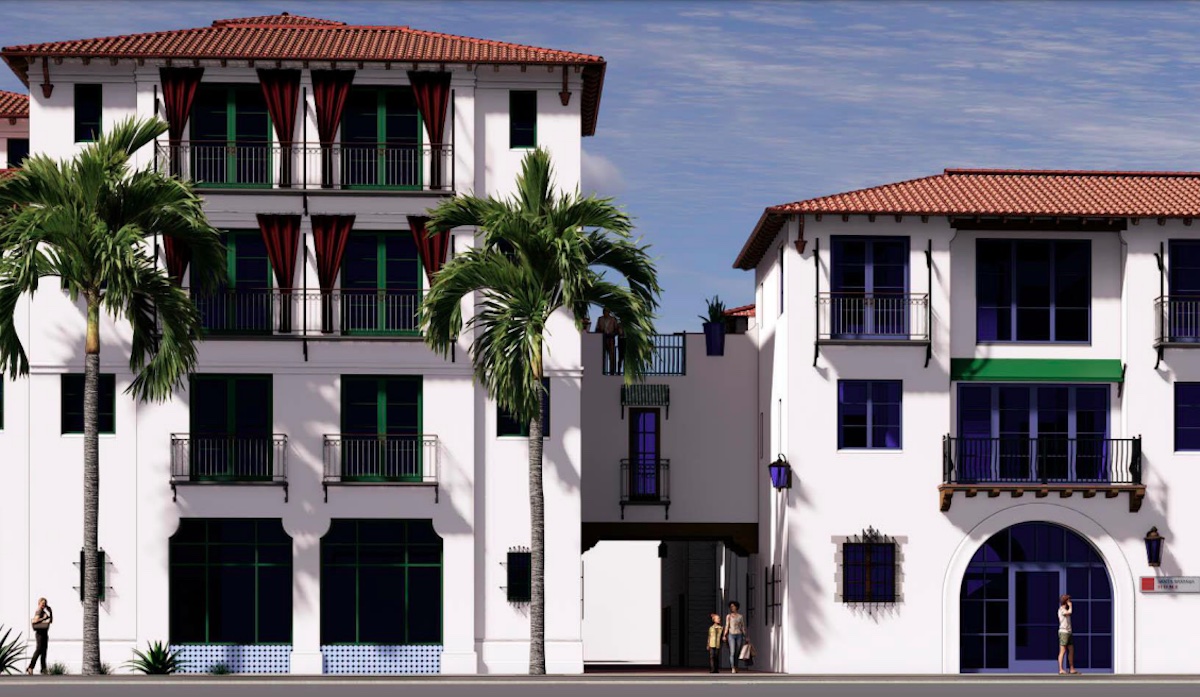While three- and four-story mixed-use developments in a Spanish Mediterranean style seem to dominate the most recent attempts at tackling housing in Santa Barbara, one project stands out as doing it “the right way” — at least according to the Historic Landmarks Commission, which gave a glowing review on Wednesday, September 14, to the proposed 39-unit adaptive reuse project on the corner of Chapala and Ortega streets.
The project sits at the site of the former Volkswagen dealership, at a property with a deep family connection spanning more than 70 years. The Van Wyk family opened the dealership in the ’50s, and it was operated by family members well into the ’90s. The family still owns the property, and enlisted architect Tom Meaney to design a pedestrian-friendly development that would perfectly fit the character of downtown Santa Barbara. Tom Meaney is the grandson of founder A.C. Van Wyk and the son of Greta Van Wyk and Jack Meaney; the late Garry Van Wyk ran the dealership for decades.
At first glance, the proposed design fits the mold of a string of similar mixed-use housing developments making their way through the city’s review boards: three to four stories tall, with the ever-present elements of white stucco, sandstone, and red-tile roofs. But Meaney — who has a background in both architecture and fine art, and was driven even more by the fact that this project is a family operation — took it a step further, incorporating new ideas and details into a visually striking take on Santa Barbara’s classic architectural style.
“I think it’s absolutely beautiful,” said Commissioner Cass Enberg, who praised Meaney’s team for addressing development priorities such as adaptive reuse of existing structures, creating four buildings spread throughout the space instead of one big mass, and adding walkable paseo and arcade spaces. “It’s just quintessential Santa Barbara,” she said.
Sign up for Indy Today to receive fresh news from Independent.com, in your inbox, every morning.
The words “romantic,” poetic,” and “artistic” were used to describe the corner property’s proposed layout, which includes a reimagining of the existing service bay — a space Meaney said is unique to the property and will be reused as a “cool, industrial loft-like space” — and variations that break up the mass into several structures surrounding a central courtyard.
“Mr. Meaney, I consider you to be a modern master, having a firm grasp on the language of Santa Barbara’s architecture, and this is a great example of that work,” said Commissioner Robert Ooley. Both Ensberg and Ooley went as far as to say the design had potential to become a “future historical landmark.”
In a city that typically picks apart new developments in drawn out back-and-forth battles, the Chapala Street project is an example of how planners and city boards can work together to achieve a common goal — even in the strict El Pueblo Viejo Landmark District. While the project received a height exemption, the designers chose to space out the units, offering 39 rentals spread over 30,000 square feet and an additional 5,000 square feet of commercial space. They were also able to provide 27 parking spaces, despite the fact that the zoning code does not require residential parking in the area.
Commission Chair Anthony Grumbine called the project “the best building” on Chapala Street. “And I do not take that lightly,” he said. “I just want to hold this up as an example of a building that got a height exception, broke the height limit, and did a great job getting straight through.”
The project design was unanimously approved and will return for a final hearing, though the only directions given to Meaney were to address noise mitigation, balcony materials, and detailing on wrought-iron and tile design. Finally, the commission gave a rare green light on creative freedom and encouraged Meaney to feel free to add “even more of a personal touch” to the project.
“Have your thumbprint on there, your personal impact,” Commissioner Ensberg said.
Support the Santa Barbara Independent through a long-term or a single contribution.




